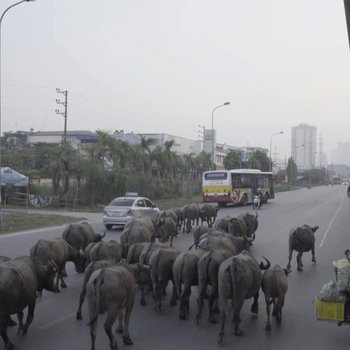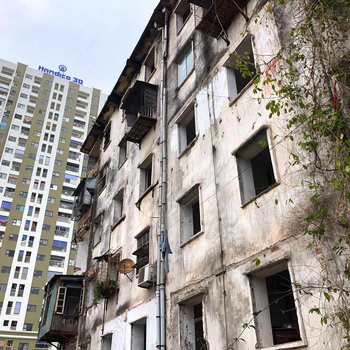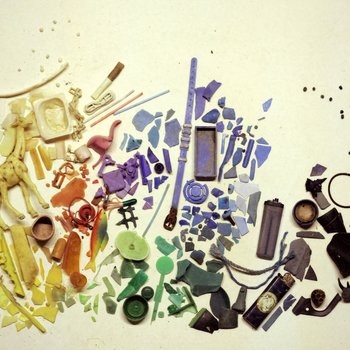Aus dem ursprünglich etwa 150 Gemälde umfassenden Œuvre des Künstlers wurden im Rahmen des Forschungsprojekts „Oskar Zwintscher (1870–1916). Das unbekannte Meisterwerk“ der Staatlichen Kunstsammlungen Dresden im Albertinum, gefördert von der Friede Springer Stiftung, 17 Werke unter kunsttechnologischen Gesichtspunkten in der Gemälderestaurierungswerkstatt untersucht.
Nach einer ersten Sichtung erfolgten die stereomikroskopische Betrachtung der Oberfläche und die Analyse mit diversen Methoden. Die komplexe Arbeitsweise des Künstlers forderte eine intensive vergleichende Auswertung sämtlicher Ergebnisse, die zu den einzelnen Gemälden im Bestandskatalog des Albertinum von 2021 zu finden sind.
Es kann festgehalten werden, dass die EINE Malmethode von Oskar Zwintscher so nicht existiert, sondern jedes untersuchte Gemälde individuelle Besonderheiten aufweist, die eine unerwartete Vielfalt und Komplexität ergeben. Dabei stellte sich die Frage, wie seine Arbeitsweise in die Umbruchphase zur Moderne einzuordnen ist, die geprägt war von zahlreichen maltechnischen Experimenten und Entwicklungen.
Zum besseren Verständnis ist voranzustellen, dass die Untersuchungen für einige Gemälde einen sehr dynamischen Malprozess offenbarten, beispielsweise nahm Oskar Zwintscher an vier Bildern Formatveränderungen während des Malens vor, indem er die Bildträger verkleinerte und die Darstellung seiner neuen Idee anpasste.
Unabhängig von einer Unterzeichnung brachte er wiederholt auf den Farbschichten Zwischenzeichnungen auf, die mit den Untersuchungsmethoden kaum voneinander zu unterscheiden sind. Zudem bezog Zwintscher oft die Rahmung in seine Arbeit ein. Drei Gemälde wurden während des Malprozesses gerahmt, und in den vom Rahmenfalz abgedeckten Randpartien sind untere Farbschichten sichtbar. Auf zwei Gemälden trug Zwintscher letzte Lasuren erst nach der Rahmung auf. An vier Gemälden war die Malschicht hingegen noch nicht getrocknet, als sie gerahmt wurden, sodass sich der Rahmenfalz in die Oberfläche eingedruckt hat. Diese Werke wurden nach der Fertigstellung zeitnah ausgestellt und daher wohl rasch eingerahmt.
Silke Beisiegel
(Auszug aus dem Katalog „Weltflucht und Moderne. Oskar Zwintscher in der Kunst um 1900“, Albertinum, Staatliche Kunstsammlungen Dresden, Dresden 2022, S. 190 ff.)
Im Folgenden besteht die Möglichkeit, anhand der Röntgenaufnahmen verschiedene Aspekte des Malprozesses nachzuvollziehen, um Einblicke in die buchstäbliche Vielschichtigkeit von Oskar Zwintschers Gemäldeaufbau zu erhalten.
Die Gattin des Künstlers als junges Mädchen, 1894
Bei diesem Bild handelt es sich um das früheste nachweisbare Porträt von Oskar Zwintschers späterer Ehefrau Adele. Die Röntgenaufnahme zeigt u.a. die erste, etwas kleinere Fassung des Kopfes sowie die Überarbeitung eines ursprünglich anders, mit pastoser Farbe und Malmesser angelegten Hintergrunds. Änderungen im Bereich der Frisur (Haarknoten) sind ebenfalls deutlich erkennbar.
Bildnis der Gattin des Künstlers, 1902
Das etwa lebensgroße Bildnis zeigt Adele Zwintscher im Alter von 30 Jahren. Die Röntgenaufnahme macht eine zunächst nach rechts gewendete Figur sichtbar, mit ausgestrecktem rechten Arm vor dem Körper. Im Hintergrund rechts war vermutlich ein Ausblick in eine Landschaft dargestellt. In der Bildmitte links erkennt man ein später wieder verdecktes Türschloss.
Selbstbildnis, 1904
Die halbfigurige Darstellung des Künstlers zeigte ursprünglich eine raumgreifendere Haltung des linken Arms. Die Kontur des rechten Arms wurde mehrfach überarbeitet. Im Hintergrund rechts sichtbare runde Napfkacheln übermalte Zwintscher später mit einem muschelförmigen, dem Jugendstil verpflichteten Ornament.
Fruchtsegen, 1913
Das Gemälde einer spätsommerlichen Landschaft hatte Zwintscher über eine bereits weit fortgeschrittene erste Bildversion gelegt. Auf dem zunächst rechts ansteigenden Hügel befand sich ein großes Haus mit Dachreiter. In der unteren Bildhälfte war eine Dachterrasse mit Lattenboden, Holzgeländer mit breiten Füllungsbrettern und Eckpfosten dargestellt.
Bildnis der Gattin des Künstlers am Meer, 1912
Der Hintergrund mit einer weiten, flächigen Küstenlandschaft und Felsenmauer war in der ersten Fassung des Bildnisses ein komplett anderer: Der Ausblick von einem schmalen Balkon zeigte eine Gartenlandschaft. Die Figur der Dargestellten blieb bis auf eine deutliche Drehung des Kopfes unverändert.
Begegnung, 1915
Blieben die zwei Figuren grundsätzlich unverändert (Ausnahme u.a. die Übermalung des rechten Ohrs der Frau), erfuhr der Hintergrund eine massive Umgestaltung: Unter der Meereslandschaft macht die Röntgenaufnahme eine felsige Umgebung sichtbar, mit einem sprudelnden Bachlauf zwischen den beiden Dargestellten.
Der Gram, 1898
Die anfangs querformatig angelegte Szene wurde durch eine Anstückung der Leinwand am oberen Bildrand vergrößert. Das Röntgenbild zeigt die erste, kleinere Darstellung der Personifikation des Todes, mit niedrigerem Buckel und schmaleren Händen. Der Felsbrocken wurde mit dem Format ebenfalls vergrößert.
Oberbürgermeister Dr. Beutler, 1910
An dem Porträt Otto Beutlers hatte Zwintscher länger gearbeitet. Auf kompositionelle Eingriffe während des Malprozesses deuten mehrfache Veränderungen des Tapetenmusters im Hintergrund (die im Infrarotreflektogramm noch deutlicher hervortreten) ebenso hin wie Veränderungen der Handpositionen: Die rechte Hand ruhte ursprünglich auf dem rechten Bein des Dargestellten, die linke auf dem Knauf der linken Armlehne.
Page [Adele Zwintscher im Pagenkostüm], 1913
Unter der aktuell sichtbaren Darstellung der stehenden Adele Zwintscher macht die Röntgenaufnahme eine erste Fassung in sitzender, nach links gewendeter Position erkennbar. War der rechte Arm angehoben und auf einem nicht näher definierbaren Gegenstand aufgelegt, befand sich der linke auf dem Schoß der Figur. Ein vertikaler Streifen am rechten Bildrand lässt die Anlage eines Vorhangs vermuten.
Zwischen Schmuck und Lied, 1910
Vergleichbar wenige gestalterische Veränderungen zeigt das Röntgenbild dieses Gemäldes. Lediglich die zentrale weibliche Figur wies anfangs ein breiteres Becken auf, das Gesicht war mehr nach links gewendet. Abweichungen sind ebenfalls in der Frisur der Frau erkennbar. Die Füße der nackten männlichen Figur rechts wurden vollständig ausgeführt, bevor die Sandalen darauf gemalt worden sind.
Eine Kooperation mit der Hochschule für Bildende Künste Dresden
Untersuchungen, Aufnahmen und Auswertungen von Silke Beisiegel, Monika Kammer, Wolfgang Kreische, Ivo Mohrmann, Kerstin Riße.
Ausstellung „Weltflucht und Moderne. Oskar Zwintscher in der Kunst um 1900“
kuratiert von Andreas Dehmer und Birgit Dalbajewa
gefördert von der Sparkassen-Finanzgruppe und der Ernst von Siemens Kunststiftung.
Albertinum Dresden, 14. 5. 2022-15. 1. 2023
Eine Kooperation mit dem Museum Wiesbaden (3. 3. 2023 - 27. 7. 2023)
Bild-Texte von Andreas Dehmer und Monika Kammer
Auch interessant:
Arlette Quynh-Anh Tran hat die erste unserer Filmreihen zum Projekt Kontrapunkte kuratiert, die sich mit den kulturellen Verwebungen der DDR und Vietnam befasst. Im Gespräch mit Kathleen Reinhardt vom Albertinum erklärt sie, welche Fragestellungen sie dabei beschäftigt haben.

Die Vernichtung von Vinh City durch die US-Bombenangriffe bot die Gelegenheit zur experimentellen Planung und Umwandlung der kleinen Industriestadt in eine sozialistische Modellstadt. Die ehrgeizige Aufgabe der DDR, der allumfassende Wiederaufbau, bestand in der gemeinsamen Arbeit an der Erstellung eines Masterplans und dessen Umsetzung in die Realität. Christina Schwenkel über den Quang Trung Wohnkomplex.

Was bleibt von uns? Aktuell eine ganze Menge. In ihrer Filmcollage "Die Hüter des Unrats - eine kurze Geschichte des Abfalls", die aktuell im Japanischen Palais zu sehen ist, wirft Susann Maria Hempel einen sarkastischen Blick auf unseren Umgang mit Müll und dessen ökologische Folgen. Über die Mägen von Raubfischen, Hühnern und Riesenschildkröten als Archiv.
